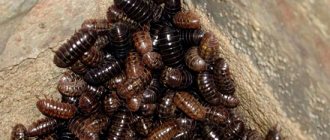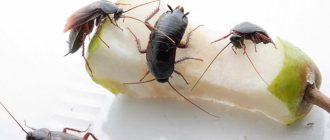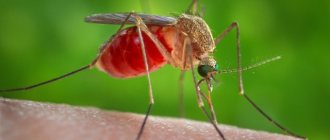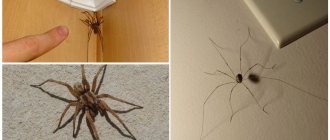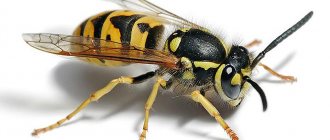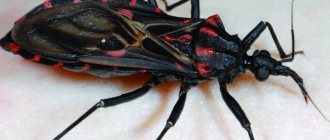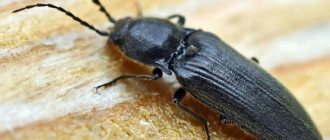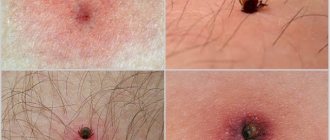Home » Interesting collections about animals
People are often afraid of insects or wary of them. Indeed, among the numerous insects there are pests and disease carriers. But there are many more harmless species; there are even useful ones that serve as irreplaceable helpers for people.
- 2 Ground beetle
- 3 Trichogramma
- 4 Lacewing
- 5 Ant
- 6 Bee
- 7 Medvedka
- 8 Silkworm
- 9 Cochineal
- 10 Lacquer bug
Ladybug
Ladybugs help in the fight against garden and vegetable pests; the most common in Russia are the seven-spotted ones. An adult insect eats 100–200 aphids and spider mites per day.
Ladybugs can be attracted by planting plants from the Asteraceae family, such as daisies, tansy or yarrow.
Ladybugs are very fertile; during their life, which lasts about one and a half years, one female lays up to 1 thousand eggs. The larvae that hatch from them are even more beneficial than the adults. During the development period, such a baby eats up to 3 thousand pests.
Ladybug larvae are sometimes mistaken for pests and destroyed
Ground beetle
Nocturnal predators that feed on other insects are of great benefit in a summer cottage. Ground beetles destroy harmful creatures - a variety of beetles, larvae, pupae and caterpillars. Even slugs and snails feed the garden nurses. In one season, a pair of ground beetles can destroy several thousand pests.
In one night, in search of food, a ground beetle can cover a distance of several kilometers.
Unfortunately, these beetles are sometimes considered pests and are destroyed. There are several species of ground beetles that are dangerous to plants, but they can be distinguished. You need to pay attention to the legs and jaws. Harmful ground beetles are stockier, with short legs and not very protruding jaws. The useful ones are large, lean, with long legs and well-developed jaw apparatus.
How harmful are insects?
In all corners of our planet, people since ancient times have been fighting insects that harm people and their households and have a negative impact on the environment.
In relation to humans, the class of insects is conventionally divided into three groups: harmful, indifferent and beneficial. But often the harm or benefit of many insects depends on the time of year and various conditions. For example, mosquitoes, annoying to people, provide an invaluable service to the inhabitants of ponds and lakes: the larvae of these insects are an important source of food for fish. Among the huge number of insects, there are many that cause serious harm to humans and animals. Blood-sucking insects that can carry pathogens of a wide variety of diseases can be very dangerous. An ordinary fly that flies into a human home can carry on its legs such dangerous diseases as dysentery, cholera, typhoid fever or roundworm eggs. The well-known tsetse fly is a serious enemy for those living in the tropics of the African continent: for humans, its bite is not fatal, but almost all domestic animals die from it quite quickly. Numerous mosquitoes bring a lot of trouble to humans, but the most dangerous among them are malaria ones. Dragonflies and insectivorous birds help people fight mosquitoes. Mosquitoes are found along the river banks and in the savannahs of South America, the bites of which cause severe torment for people and animals. A mosquito bite resembles a drop of boiling oil falling on the skin; mosquito victims become completely unrecognizable. When there is a large concentration, these insects penetrate the ears, nose, mouth, and eyes.
Lice and fleas are parasites that are also carriers of dangerous diseases (typhoid and plague). Parasitic lice are usually found in cows and pigs, and fleas are usually found in dogs, birds, and rats.
Livestock farming often suffers from horseflies and gadflies: a large number of these flying insects on pastures does not allow domestic animals to eat normally and causes a decrease in milk yield. In addition, the larvae of some gadflies can penetrate internal organs and subsequently cause the appearance of purulent nodules. Few people find it pleasant to live “neighborhood” with parasites. Owners often have to deal with cockroaches, bedbugs, fleas, and house ants. Red cockroaches cause big problems for humans. Prussians are not easy to get rid of as they are very prolific. The danger of these insects lies in the fact that cockroaches are capable of carrying pathogens of dangerous diseases. Compliance with basic sanitary standards in the apartment will help, along with the necessary treatment, to get rid of these unpleasant “neighbors”.
The food for bed bugs is human blood, so they appear at night and find the “victim” from a long distance by smell. During the day, bedbugs hide in cracks, behind wallpaper, ceilings and curtains. In addition to the troubles from bites, bedbugs are dangerous for humans as carriers of infection, so it is important to declare “war” on them immediately, perhaps even throwing away furniture or inviting specialists.
Fleas usually come into the home from pets. They are dangerous to humans as carriers of viruses and microbes. Disinfecting pet rugs and regularly keeping them clean will eliminate the presence of these insects.
Many other representatives of insects can also live in a person’s home, including: house ants, moths, woodlice, and various bugs. All of them also cause trouble for people, pets and plants.
Video on the topic
Sources:
- Damage caused by insects
- Harmful insects
- Insects in the apartment and house
How harmful are insects?
www.kakprosto.ru
Trichogramma
Not everyone knows about such an insect as Trichogramma. But this miniature creature brings invaluable benefits - it fights representatives of more than 70 species of pests. Moreover, it destroys not adult individuals, but eggs - Trichogramma lays larvae in them, which, as they develop, destroy the contents. In one season, a female can lay 500–800 eggs.
Trichogramma is an egg-eater from the order Hymenoptera, the smallest insect measuring 0.4 - 0.9 mm
The ability to eradicate pests on a large scale makes Trichogramma an alternative to chemical insecticides. It is even bred on an industrial scale and sold to gardeners.
Damage from insects
Since ancient times, in every corner of the globe, people have been fighting insects. More precisely, with those insects that cause harm to humans and their households. If you want to know the best folk remedies for bedbugs, then read the article https://beetlestop.ru/narodnyie-sredstva-ot-klopov/. All insects can be divided into three types: harmful, neutral and beneficial. Their benefits and harms may vary depending on the time of year or weather conditions. For example, such annoying and terrible mosquitoes, which do not allow a person to live in peace, are of invaluable benefit to the inhabitants of rivers and lakes. Mosquito larvae are food for a variety of fish.
What harm do insects cause to people and animals?
The most harmful and dangerous are blood-sucking insects. They are carriers of a wide variety of diseases. An ordinary fly, harmless at first glance, can easily carry cholera, dysentery and other diseases on its legs. And the famous tsetse fly, which lives in the tropics, can bring death to animals with one bite. Malaria mosquitoes bring much more harm to humans. But at the same time, they provide food for dragonflies and insectivorous birds.
Other harmful insects that can easily transmit diseases are fleas and lice. Such parasites are often found in animals. Animals are affected by horse flies and gadflies, they do not allow domestic animals to eat properly and significantly reduce milk yield. It is not very pleasant to live with insect pests, such as bedbugs, cockroaches, ants or fleas. Red cockroaches cause particular trouble for humanity. They are not easy to get rid of because these insects reproduce very quickly. The harm from such cockroaches is that they carry many serious diseases. As soon as these residents are discovered in the premises, it is necessary to immediately begin to fight them.
Bedbugs that live in bedding are no less dangerous to humans. They are active only in the dark, identifying a person by his smell. During daylight hours, bedbugs hide in baseboards, wallpaper, and behind curtains. In addition to bites, they also carry various diseases. Very often fleas appear in a house where there are pets. In such houses it is necessary to regularly disinfect the premises and treat animals.
Other insects are often found in residential buildings: moths, red ants, beetles. It is also necessary to combat them, since in addition to harm from insects to humans, they cause harm to furniture, clothing, and indoor plants.
www.vsefishki.com
Lacewing
Attractive pale green insects prey on aphids and mites. Lacewings were the first to be specially bred to protect greenhouse plants from pests.
In summer, lacewings often fly into apartments - at night they are attracted to electric light
If you touch an insect, an unpleasant odor will appear. But lacewings are harmless to humans.
Ant
It’s not for nothing that forest ants are called little workers - they protect plants from caterpillars and larvae, slugs, spider mites and other insects. The inhabitants of one anthill control an area of about 0.2 hectares. Also, thanks to the activity of ants, the content of potassium and phosphorus in the soil increases.
It is worth monitoring the number of ants, because they can contribute to the proliferation of aphids
These insects are also used to make medicine. Formic acid is used as a stimulant and astringent. Some are even treated with ant bites. But here you need to be careful, because the individual reaction of the body can be negative.
Bee
The importance of bees can hardly be overestimated, because these hardworking insects pollinate plants and produce honey, which is used in cooking, for cosmetic purposes, and for the treatment of diseases. And other beekeeping products - bee bread, propolis, royal jelly, bee venom - are no less useful. All of them are natural antibiotics.
Pollination of plants by bees improves the quality of seeds, increases the size, juiciness and taste of fruits
Even beehives and dead insects are beneficial. Wax is made from honeycombs, and medicinal tinctures are made from bee pestilence.
Medvedka
Mole crickets are usually considered malicious pests, because they gnaw the roots of plants while burrowing in the ground. Although some see the benefit of the insect, since it is partly a predator and can eat creatures that are no less dangerous to the flora, such as the larvae of the cockchafer.
For treatment, the mole cricket is caught in environmentally friendly places; insects that come into contact with chemicals will be toxic
Medvedka made it to the top because of its healing properties. In China, for a long time, it has been used to treat various diseases, including severe ones - tuberculosis, cirrhosis, diabetes.
The role of insects in biocenoses
Insects play a huge role in land biocenoses.
Their importance in the biogenic cycle is great. Among the insects there are:
- consumers of the first order, consuming green mass of plants, phytophages;
- consumers of the second and third orders, feeding on plants and animals, predators and parasites;
- decomposers are destroyers of various organic residues.
Example 1
Butterfly caterpillars, leaf beetles, aphids, and weevils feed on plants. They are destroyed by predatory insects (ladybugs, ground beetles, ants, bugs) and parasites (hopper larvae, tachine flies).
Saprophagous insects (cockroaches, primary wingless) process plant residues. Xylophages feed on wood (bark beetles, termites, larvae of borers, longhorned beetles). Many insects have symbionts (flagellates, bacteria) in their intestines that facilitate the digestion of fiber. Animal remains are eaten by skin beetles, mervoeders, and dipteran larvae. Animal excrement is disposed of by dung flies and beetles.
Finished works on a similar topic
- Coursework The importance of insects in nature and human life 490 rub.
- Abstract The importance of insects in nature and human life 270 rub.
- Test work The importance of insects in nature and human life 210 rub.
Receive completed work or specialist advice on your educational project Find out the cost
Note 1
All saprophagous and xylophagous insects contribute to the formation of soil.
Large animals - reptiles, amphibians, birds and mammals feed on insects. Almost all songbirds feed their offspring with insects. Insects are an important factor in regulating the numbers of both plants and animals. Phytophages destroy mainly weakened plants, as well as species that are not characteristic of these communities.
Example 2
Ants control the number of species inhabiting meadows, forests, and deserts. Ladybugs are able to suppress the number of homoptera insects (aphids). Zhizhelitsy destroy arachnids, soil-dwelling insects, and mollusks.
Coevolution of insects and angiosperms has led to mutual adaptations in phytophagy and pollination. Insects are the main pollinators of flowering plants and the yields of berries and fruit crops depend on their activity. A large number of different species utilize dead organic material: wood, leaf litter, manure, etc.
Have questions about this topic? Ask a question to the teacher and get an answer in 15 minutes! Ask a Question
Silkworm
We have silkworms to thank for the silk items in our wardrobes. The caterpillars of these butterflies produce silk. More precisely, silk fiber from which the insect builds its cocoon. One larva is capable of producing 15 cm of mulberry in a minute. And in the cocoon of this thread there can be about a kilometer.
The silkworm is unknown in the wild; it was domesticated several thousand years ago in China.
Other types of silkworms are sometimes bred, but they produce fiber of poorer quality.
Diversity
In the photo: Mosquito.
Among the most important orders of insects, two large groups are distinguished. These are species with complete transformation, and the second group includes insects with incomplete transformation.
The division of the body into three parts, as well as antennae and compound eyes are the most important characteristics of insects. In addition, vision plays the most important role in nocturnal insects, but daytime insects navigate in space with the help of other organs.
A striking feature of insects is their extraordinary diversity. Flying, crawling, running, swimming, they all play their role in living nature.
Top 10 Examples of the Importance of Insects
And now directly to the usefulness of these little inhabitants of the planet.
Cochineal
Several species of insects from which the red dye carmine is made are collectively called cochineal. Carminic acid, which is the main component of paint, is extracted from female cochineal scale insects.
Ararat, oak, Mexican and Polish cochineal are combined under the general name cochineal.
Dyes from these insects were obtained back in the 6th century BC.
History of discovery
The discovery of chitin dates back to 1811, when Professor Henry Braconneau first discovered it in mushrooms. The scientist began to study with particular interest an unknown substance that was not susceptible to the influence of sulfuric acid. Then (in 1823) this substance was discovered in the wings of cockchafers and called it “chitin”, which in Greek means “clothing, shell”. This material was structurally similar to cellulose, but was much stronger. The structure of chitin was first determined by the Swiss chemist Albert Hofmann. And in 1859, the scientific world learned about chitosan. After chemists “purified” chitin from calcium and proteins. This substance, as it turns out, has a beneficial effect on almost all organs and systems of the human body.
Over the next century, interest in chitin faded a little, and only in the 1930s it grew with renewed vigor. And in the 1970s, the production of a substance from mollusk shells began.


